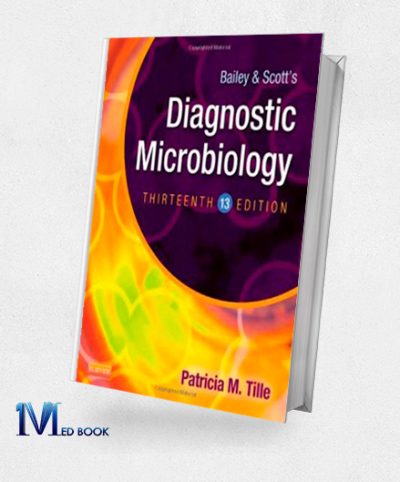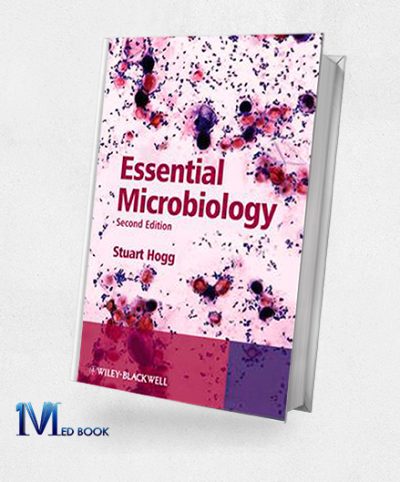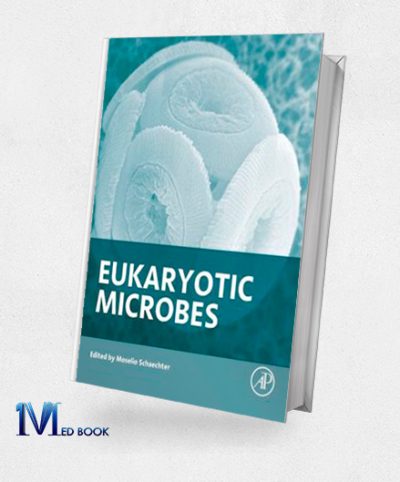Microbiology
A Manual of Basic Microsurgical Techniques (Original PDF from Publisher)
Original price was: $99.95.$24.00Current price is: $24.00.Advances in Arthropod Repellents (Original PDF from Publisher)
Original price was: $170.00.$27.00Current price is: $27.00.Automation and Emerging Technology in Clinical Microbiology An Issue of Clinics in Laboratory Medicine 1st Edition (The Clinics Internal Medicine)
Original price was: $89.46.$24.90Current price is: $24.90.Bailey and Scotts Diagnostic Microbiology 13th Edition (Original PDF from Publisher)
Original price was: $112.49.$26.10Current price is: $26.10.Bensons Microbiological Applications Laboratory Manual in General Microbiology Short Version 13th Edition
Original price was: $114.12.$24.00Current price is: $24.00.BIOS Instant Notes in Microbiology 4th Edition (Original PDF from Publisher)
Original price was: $30.30.$21.00Current price is: $21.00.Brock Biology of Microorganisms 14th Edition (Original PDF from Publisher)
Original price was: $177.48.$26.00Current price is: $26.00.Chronic Hepatitis B and C Basic Science to Clinical Applications (Original PDF from Publisher)
Original price was: $107.00.$21.00Current price is: $21.00.Clinical Microbiology and Infectious Diseases An Illustrated Colour Text 2nd Edition
Original price was: $61.95.$23.40Current price is: $23.40.Clinical Mycology 2nd Edition (Original PDF from Publisher)
Original price was: $178.71.$29.90Current price is: $29.90.Clinical Parasitology A Practical Approach (Original PDF from Publisher)
Original price was: $56.25.$23.10Current price is: $23.10.Diagnostic Medical Parasitology 5th Edition (Original PDF from Publisher)
Original price was: $119.16.$22.00Current price is: $22.00.Elseviers Integrated Review Immunology and Microbiology 2nd Edition (Original PDF from Publisher)
Original price was: $31.96.$21.70Current price is: $21.70.Essential Microbiology 2nd Edition (Original PDF from Publisher)
Original price was: $86.00.$21.00Current price is: $21.00.Essential Microbiology for Dentistry 4th (Original PDF from Publisher)
Original price was: $76.39.$24.10Current price is: $24.10.Eukaryotic Microbes (ORIGINAL PDF from Publisher)
Original price was: $100.98.$25.60Current price is: $25.60.HIV Essentials 2013 6th Edition (Original PDF from Publisher)
Original price was: $32.55.$21.60Current price is: $21.60.Human Parasitology Fourth Edition (Original PDF from Publisher)
Original price was: $78.99.$24.30Current price is: $24.30.Laboratory Applications in Microbiology A Case Study Approach 3rd Edition
Original price was: $118.89.$25.00Current price is: $25.00.Laboratory Experiments in Microbiology (10th Edition)
Original price was: $107.10.$26.00Current price is: $26.00.Lippincotts Illustrated Reviews Flash Cards Microbiology
Original price was: $35.99.$22.00Current price is: $22.00.Lippincotts Microcards Microbiology Flash Cards Third Edition
Original price was: $31.47.$20.40Current price is: $20.40.Medical Microbiology 18th Edition (Original PDF from Publisher)
Original price was: $70.00.$24.00Current price is: $24.00.Microbiology
Introduction to Microbiology:
Microbiology serves as the key to unlocking the mysteries of the microscopic world, encompassing the study of diverse microorganisms such as bacteria, viruses, fungi, and parasites. The significance of microbiology extends across various realms, influencing human health, the environment, and multiple industries. In this scientific discipline, researchers delve into the intricate structures and functions of microorganisms, unraveling their roles in both beneficial and detrimental aspects of life. Microbiology plays a crucial role in understanding infectious diseases, developing antibiotics and vaccines, and exploring the symbiotic relationships between microorganisms and their hosts. Beyond healthcare, microbiology influences environmental processes, contributing to waste management, bioremediation, and the cycling of nutrients. Industries such as food production, pharmaceuticals, and biotechnology also rely on microbiological insights for innovations. This introduction aims to illuminate the pervasive impact of microbiology on our world, from safeguarding human health to shaping the ecological balance and fostering advancements in numerous sectors.
Types of Microorganisms Studied in Microbiology:
Microbiology encompasses the study of an extensive array of microorganisms, each belonging to distinct groups with unique characteristics and roles. Bacteria, among the most abundant life forms, exhibit diverse shapes and metabolic activities. Archaea, often thriving in extreme environments, contribute to ecosystem functions like nutrient cycling. Viruses, known for their simplicity and ability to infect hosts, play pivotal roles in disease and evolutionary processes. Fungi, including yeasts and molds, contribute to nutrient cycling and have industrial applications. Protists, a diverse group of eukaryotic microorganisms, impact aquatic ecosystems and serve as models in research. Understanding the characteristics and roles of these microorganisms is fundamental in unraveling their significance in ecosystems and human-related activities, spanning agriculture, medicine, and environmental management. This exploration into the microbial world showcases the diverse contributions of microorganisms to the intricate web of life on Earth.
Microbial Structure and Function:
Microorganisms, encompassing bacteria, archaea, viruses, fungi, and protists, exhibit remarkable structural and functional diversity, enabling their proliferation across various environments. Bacteria and archaea, both prokaryotic domains, showcase diverse shapes and sizes, with intricate cellular structures that facilitate essential metabolic processes. Viruses, consisting of genetic material encapsulated in protein coats, lack cellular structures but are adept at hijacking host machinery for reproduction. Fungi, composed of eukaryotic cells, exhibit varied structures such as yeasts and hyphae, contributing to their roles in nutrient cycling and symbiotic relationships. Protists, encompassing eukaryotic microorganisms, demonstrate versatile cellular organization and functions, from photosynthesis to parasitic interactions.
Microorganisms employ a range of metabolic processes, including glycolysis, fermentation, and respiration, allowing them to derive energy from diverse substrates. Adaptations such as extremophiles in archaea enable survival in extreme environments, while bacterial biofilms enhance resistance to adverse conditions. These microorganisms play crucial roles in nutrient cycling, symbiosis, and ecological balance. Understanding the intricacies of their structure and function is paramount in deciphering their contributions to ecosystems and exploiting their potential for various applications, from biotechnology to environmental remediation.
Microbial Ecology and Environmental Impact:
Microbial ecology delves into the intricate relationships microorganisms share with their environments, elucidating their profound impact on ecosystems. Microorganisms play pivotal roles in nutrient cycling, shaping the availability and distribution of essential elements. Bacteria and fungi, for instance, decompose organic matter through processes like decomposition and mineralization, releasing nutrients back into the ecosystem. This nutrient cycling is fundamental to sustaining life and maintaining ecological balance.
Furthermore, microorganisms exhibit remarkable capabilities in bioremediation, actively participating in the removal or degradation of pollutants. Certain bacteria and fungi possess enzymes that break down contaminants, contributing to the detoxification of soil and water. This microbial prowess has been harnessed in environmental restoration efforts, showcasing their potential to mitigate human-induced environmental damage.
The overall balance of ecosystems is intricately tied to the activities of microorganisms. Their interactions with plants, animals, and each other influence the health and resilience of ecosystems. Additionally, microorganisms modulate the global carbon and nitrogen cycles, influencing climate regulation and atmospheric composition.
Understanding microbial ecology and the environmental impact of microorganisms is indispensable for sustainable environmental management. Harnessing their natural capabilities in nutrient cycling and bioremediation holds promise for fostering resilient ecosystems and addressing environmental challenges.
Role of Microorganisms in Human Health:
Microorganisms play a multifaceted role in human health, influencing various aspects of our well-being. One of the key aspects is the symbiotic relationship between humans and their microbiota. The human body is home to trillions of microorganisms, collectively known as the microbiota, residing predominantly in the gastrointestinal tract, skin, and other mucosal surfaces. This symbiotic relationship is essential for maintaining overall health.
The human microbiome, which refers to the collective genetic material of the microorganisms inhabiting the body, is crucial for numerous physiological processes. Microorganisms aid in digestion, produce essential vitamins, and contribute to the development and regulation of the immune system. This intricate interplay between the human host and its microbiota is essential for maintaining a balanced and functional internal environment.
Conversely, pathogenic microorganisms have the potential to cause diseases. Pathogens can be bacteria, viruses, fungi, or parasites that disrupt the balance of the microbiota or directly harm human cells. Infections caused by pathogenic microorganisms can lead to a range of illnesses, from minor infections to serious and life-threatening diseases.
Understanding the delicate balance between beneficial and pathogenic microorganisms is vital for maintaining human health. Research in microbiology has shed light on how disruptions in the microbiota, often due to factors such as antibiotic use or diet, can impact health and contribute to conditions like inflammatory bowel disease, allergies, and metabolic disorders. The field of microbiology continues to explore ways to harness the potential of beneficial microorganisms for therapeutic purposes, such as probiotics and fecal microbiota transplantation, to restore and maintain a healthy microbiome.
Microbiology in Medicine and Biotechnology:
Microbiology plays a pivotal role in advancing medicine and biotechnology through a myriad of applications, leveraging various microbiological techniques. In the realm of medical diagnostics, microbiology is indispensable for identifying and characterizing infectious agents responsible for diseases. Microbiological techniques, such as culturing and molecular diagnostics, are employed to isolate and detect pathogens, aiding clinicians in accurate diagnosis and treatment.
Vaccine development represents another crucial application of microbiology. Microorganisms, attenuated or inactivated, serve as the basis for vaccines, stimulating the immune system to confer protection against specific diseases. Microbiologists play a key role in isolating, characterizing, and modifying these microorganisms to create safe and effective vaccines.
In the pharmaceutical industry, microbiology is integral to the production of various medicines. Microbial fermentation processes are employed to produce antibiotics, insulin, and other biopharmaceuticals. Microorganisms, genetically engineered to express therapeutic proteins, contribute to the large-scale production of pharmaceuticals, ensuring a stable and reliable supply.
Biotechnology harnesses microbiological techniques for the production of biofuels, offering sustainable alternatives to traditional energy sources. Microorganisms, such as certain bacteria and yeast, are engineered to ferment organic materials into biofuels like ethanol and biodiesel. This application aligns with the global pursuit of environmentally friendly and renewable energy solutions.
In essence, microbiology serves as a cornerstone in medical and biotechnological advancements. Its techniques and insights continue to drive innovations that impact human health, contribute to the development of life-saving vaccines, and facilitate the sustainable production of pharmaceuticals and biofuels. The ongoing collaboration between microbiologists and other scientific disciplines ensures that these applications remain at the forefront of scientific progress, shaping the future of medicine and biotechnology.
Microbial Pathogenesis and Infectious Diseases:
Microbial pathogenesis, the study of how microorganisms cause infectious diseases, is a complex interplay between pathogens and host organisms. Pathogens, which include bacteria, viruses, fungi, and parasites, have evolved intricate strategies to invade host tissues, evade immune responses, and establish infections, contributing to the development of various diseases.
The process of microbial invasion often begins with adherence to host cells, facilitated by specific surface molecules on the pathogen that interact with host cell receptors. Once attached, pathogens can breach host barriers through mechanisms such as the secretion of enzymes or toxins that degrade or disrupt host tissues. In the case of viruses, they may enter host cells and hijack cellular machinery for replication.
Evading the host immune system is a critical aspect of microbial pathogenesis. Pathogens have evolved mechanisms to avoid detection, resist immune attack, and even manipulate host immune responses. Some bacteria can resist phagocytosis, a key immune defense, by modifying their surface structures. Others can produce molecules that inhibit the activation of immune cells or interfere with signaling pathways.
The outcomes of microbial infections vary widely, ranging from mild, self-limiting diseases to severe, life-threatening conditions. Chronic infections can arise when pathogens establish persistent infections, evading the immune system or residing in immune-privileged sites. Additionally, some infections can lead to chronic inflammation, contributing to the development of diseases such as cancer.
Understanding microbial pathogenesis is crucial for developing effective strategies to prevent and treat infectious diseases. Advances in this field have led to the development of vaccines, antimicrobial drugs, and improved diagnostics. Ongoing research continues to unravel the intricate molecular mechanisms employed by microorganisms, providing insights that inform the development of targeted therapies and interventions to mitigate the impact of infectious diseases on global health.
Emerging Infectious Diseases and Microbiology:
The field of microbiology faces significant challenges posed by emerging infectious diseases (EIDs), which are diseases that have recently appeared in a population or have existed but are rapidly increasing in incidence or geographic range. Several factors contribute to the emergence of new diseases, and microbiologists play a crucial role in surveillance and response efforts.
- Zoonotic Transmission: Many emerging infectious diseases originate in animals and can be transmitted to humans, known as zoonotic transmission. Changes in land use, urbanization, and encroachment into wildlife habitats increase the likelihood of contact between humans and animals, facilitating the transmission of novel pathogens.
- Globalization and Travel: Increased international travel and trade contribute to the rapid spread of infectious agents across borders. Microbes can be transported globally within a short period, leading to outbreaks in new regions.
- Antimicrobial Resistance: The misuse and overuse of antibiotics have contributed to the rise of antimicrobial resistance, making it challenging to treat infectious diseases. Resistant strains of bacteria, viruses, and other pathogens pose a serious threat to public health.
- Climate Change: Changes in climate patterns can affect the distribution of vectors (such as mosquitoes and ticks) and alter the geographic range of infectious diseases. This can result in the spread of diseases to new areas.
- Behavioral and Societal Factors: Human behavior, including practices related to hygiene, food consumption, and healthcare-seeking behavior, can influence the emergence and spread of infectious diseases. Socioeconomic factors also play a role in disease dynamics.
Microbiologists are at the forefront of efforts to address these challenges:
- Surveillance: Microbiologists contribute to surveillance systems that monitor the prevalence and spread of infectious agents. Early detection is crucial for effective response.
- Diagnosis: Microbiologists develop and improve diagnostic tools to identify emerging pathogens quickly. Accurate and timely diagnosis is essential for effective patient management and outbreak control.
- Research: Microbiologists research to understand the biology, transmission dynamics, and host interactions of emerging pathogens. This knowledge informs the development of preventive measures and therapeutics.
- Vaccine Development: Microbiologists play a key role in developing vaccines to prevent the spread of infectious diseases. Vaccination is a critical tool in controlling outbreaks and reducing the impact of emerging infections.
- Public Health Response: Microbiologists collaborate with public health agencies to design and implement strategies for controlling outbreaks. This includes quarantine measures, public awareness campaigns, and community engagement.
Addressing the challenges of emerging infectious diseases requires a multidisciplinary approach, with microbiologists working in tandem with epidemiologists, clinicians, public health officials, and policymakers to develop comprehensive strategies for surveillance, prevention, and response.
Current Trends and Innovations in Microbiology:
Microbiology is a rapidly evolving field with several current trends and innovations that highlight its dynamic nature:
- CRISPR Technology: Clustered Regularly Interspaced Short Palindromic Repeats (CRISPR) and CRISPR-associated (Cas) proteins have revolutionized genetic engineering. Microbiologists leverage CRISPR technology for precise gene editing, enabling them to modify microbial genomes for various applications, including medical research, agriculture, and industrial processes.
- Synthetic Biology: Synthetic biology involves designing and constructing new biological parts, devices, and systems or redesigning existing biological systems for useful purposes. In microbiology, synthetic biology techniques are employed to engineer microorganisms with novel functionalities, such as producing biofuels, pharmaceuticals, and industrial chemicals.
- Microbiome Research: The microbiome, comprising the diverse communities of microorganisms living in and on the human body, animals, plants, and various environments, is a focal point in microbiological research. Advances in DNA sequencing technologies have enabled detailed analysis of microbiomes, revealing their crucial roles in health, disease, and ecosystem functioning. Microbiome research has implications for personalized medicine, agriculture, and environmental conservation.
- Antimicrobial Resistance (AMR) Studies: With the rise of antimicrobial resistance poses a global threat, microbiologists are intensively studying mechanisms of resistance, developing new antimicrobial agents, and exploring alternative approaches to combat infections. Understanding the genetic basis of resistance helps in the design of effective treatment strategies.
- Microbial Biotechnology: Microorganisms are harnessed for various biotechnological applications. Microbial biotechnology involves using bacteria, fungi, and other microorganisms to produce valuable products, including enzymes, biofuels, and pharmaceuticals. Advances in fermentation technologies and genetic engineering enhance the efficiency and scalability of microbial bioprocessing.
- Microbial Ecology and Environmental Microbiology: Microbiologists are increasingly focused on understanding microbial communities in diverse ecosystems. This includes studying extremophiles, and microorganisms thriving in extreme environments, and investigating microbial contributions to nutrient cycling, bioremediation, and climate-related processes.
- Single-Cell Microbiology: Traditional microbiological methods often analyze populations of microorganisms, masking individual variations. Single-cell microbiology involves studying microorganisms at the single-cell level, providing insights into heterogeneity within microbial populations, and improving our understanding of microbial behavior in complex environments.
- Metagenomics and Metatranscriptomics: Advances in metagenomics and metatranscriptomics allow the analysis of genetic material and gene expression of entire microbial communities. This helps uncover the functional potential and activities of diverse microorganisms, especially in complex environments like soil, oceans, and the human gut.
These trends showcase the transformative impact of microbiology on various scientific and applied fields. As technology continues to advance, microbiologists are well-positioned to explore new frontiers, contributing to innovations that address global challenges in health, agriculture, industry, and environmental sustainability.
Conclusion:
Microbiology is a cornerstone of scientific inquiry that plays a pivotal role in unraveling the mysteries of the microscopic world. Its applications extend across diverse domains, influencing scientific research, medical diagnostics, and industrial processes. Several critical aspects highlight the significance of microbiology.
Firstly, microbiology has deepened our understanding of the intricate structures and functions of microorganisms, including bacteria, viruses, fungi, and parasites. The exploration of microbial ecology has illuminated their roles in nutrient cycling, bioremediation, and their profound influence on the delicate balance of ecosystems.
The symbiotic relationships between microorganisms and human health underscore the importance of the human microbiome. Microbiology has elucidated the complexities of these relationships, impacting not only our understanding of disease but also fostering innovative approaches in medical diagnostics, vaccine development, and pharmaceutical production.
Microbiology’s role in addressing global health challenges is evident in the study of infectious diseases and the constant evolution of pathogenic microorganisms. The field’s contribution to surveillance and response efforts, especially in the face of emerging infectious diseases, emphasizes its crucial role in safeguarding public health.
Advancements in microbiological techniques, such as CRISPR technology and synthetic biology, have revolutionized genetic engineering and the design of microorganisms for specific purposes. These innovations have far-reaching implications, from sustainable biofuel production to the development of novel therapeutic solutions.
In the realm of environmental microbiology, ongoing research sheds light on the impact of microorganisms on climate-related processes, showcasing the field’s relevance in addressing global challenges such as climate change and environmental degradation.
As we move forward, microbiology continues to evolve, with emerging trends and technologies shaping its trajectory. The dynamic nature of the field positions microbiologists at the forefront of addressing contemporary challenges. Whether in the quest for novel antimicrobial solutions, the exploration of microbial communities in diverse ecosystems, or the integration of microbiome research into personalized medicine, microbiology remains instrumental in shaping the future.
In conclusion, microbiology bridges the microscopic and macroscopic worlds, offering profound insights and practical applications. The ongoing advancements in microbiology underscore its indispensable role in addressing global challenges and advancing knowledge across scientific, medical, and industrial domains.

























